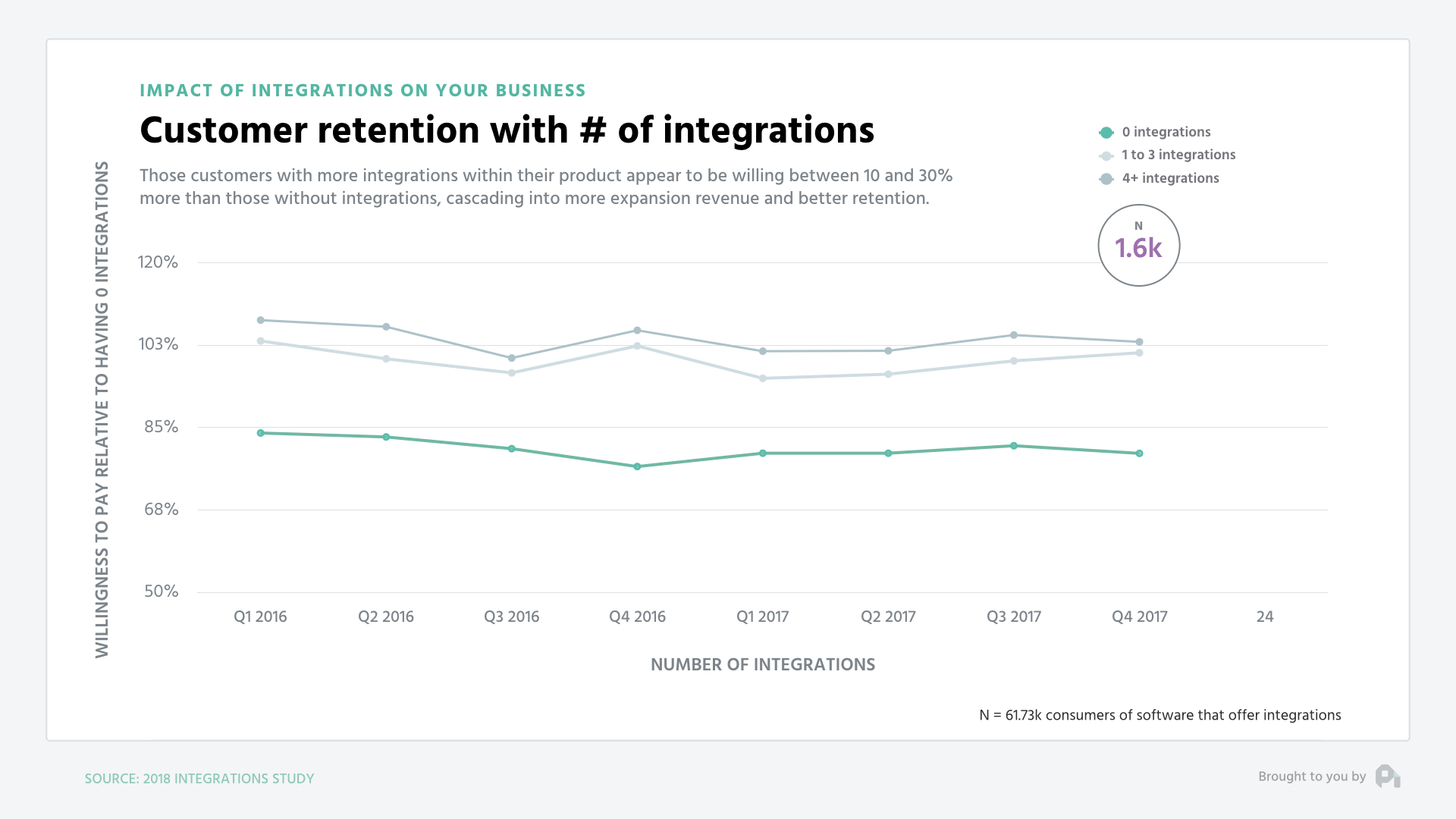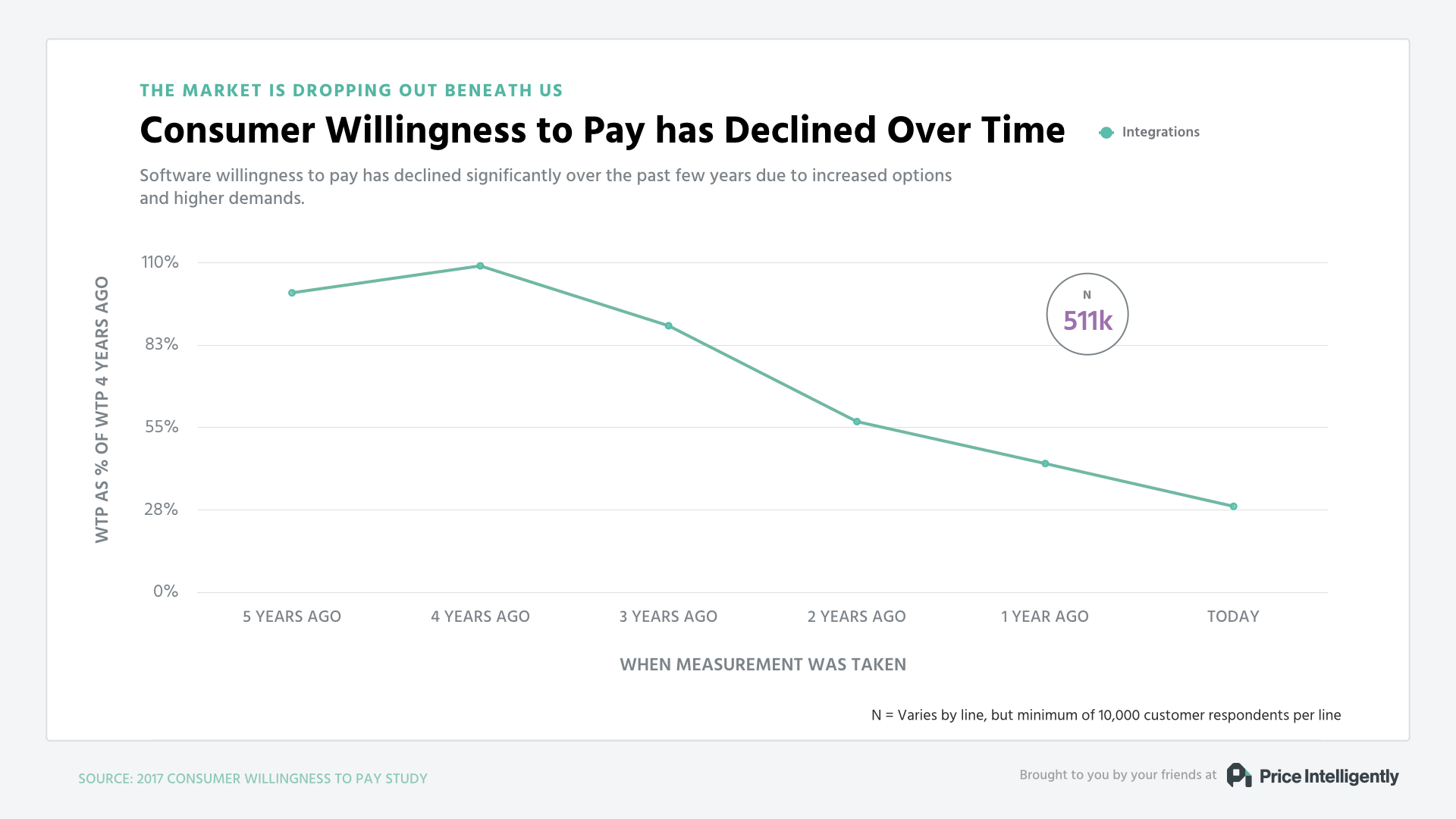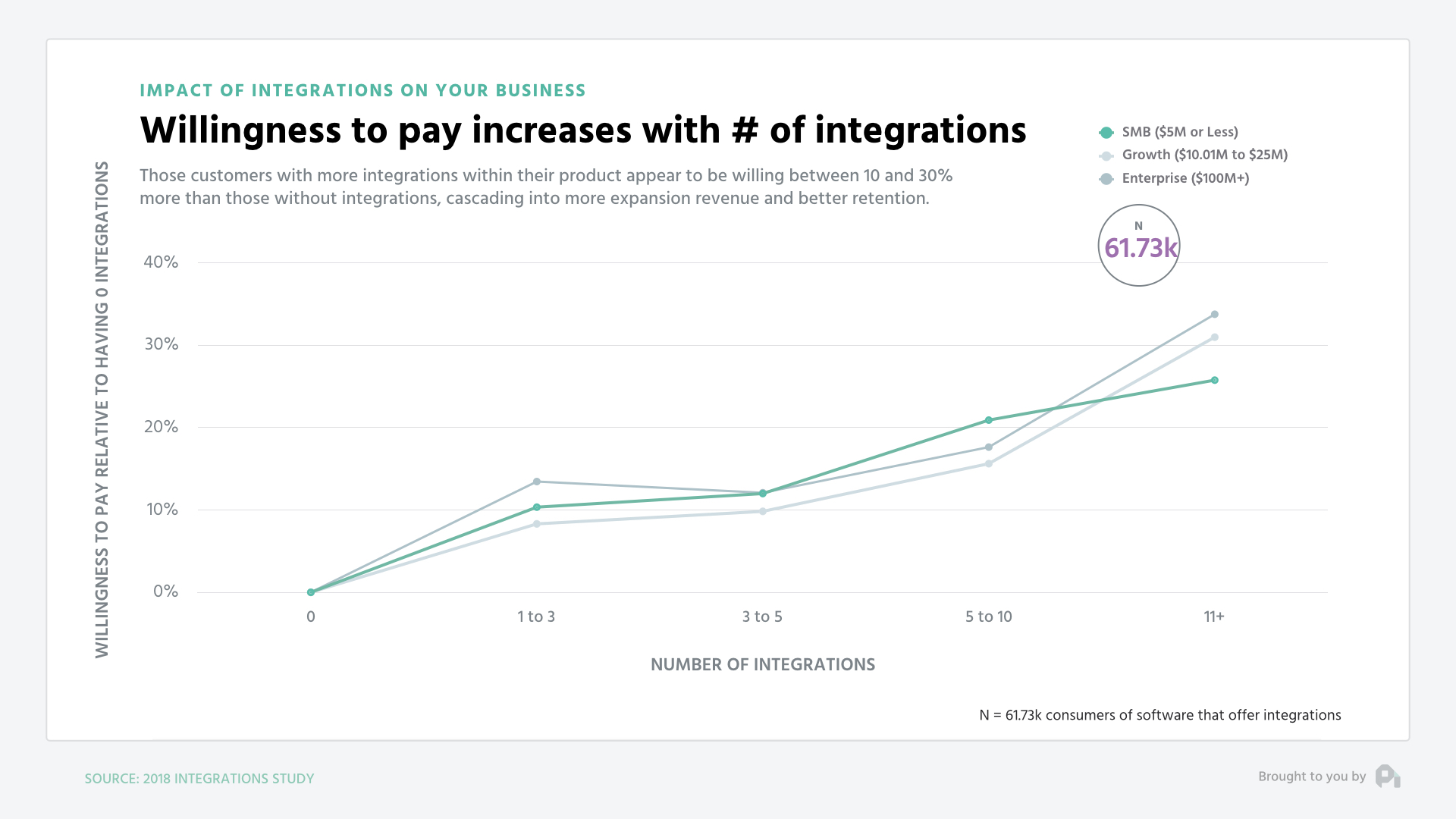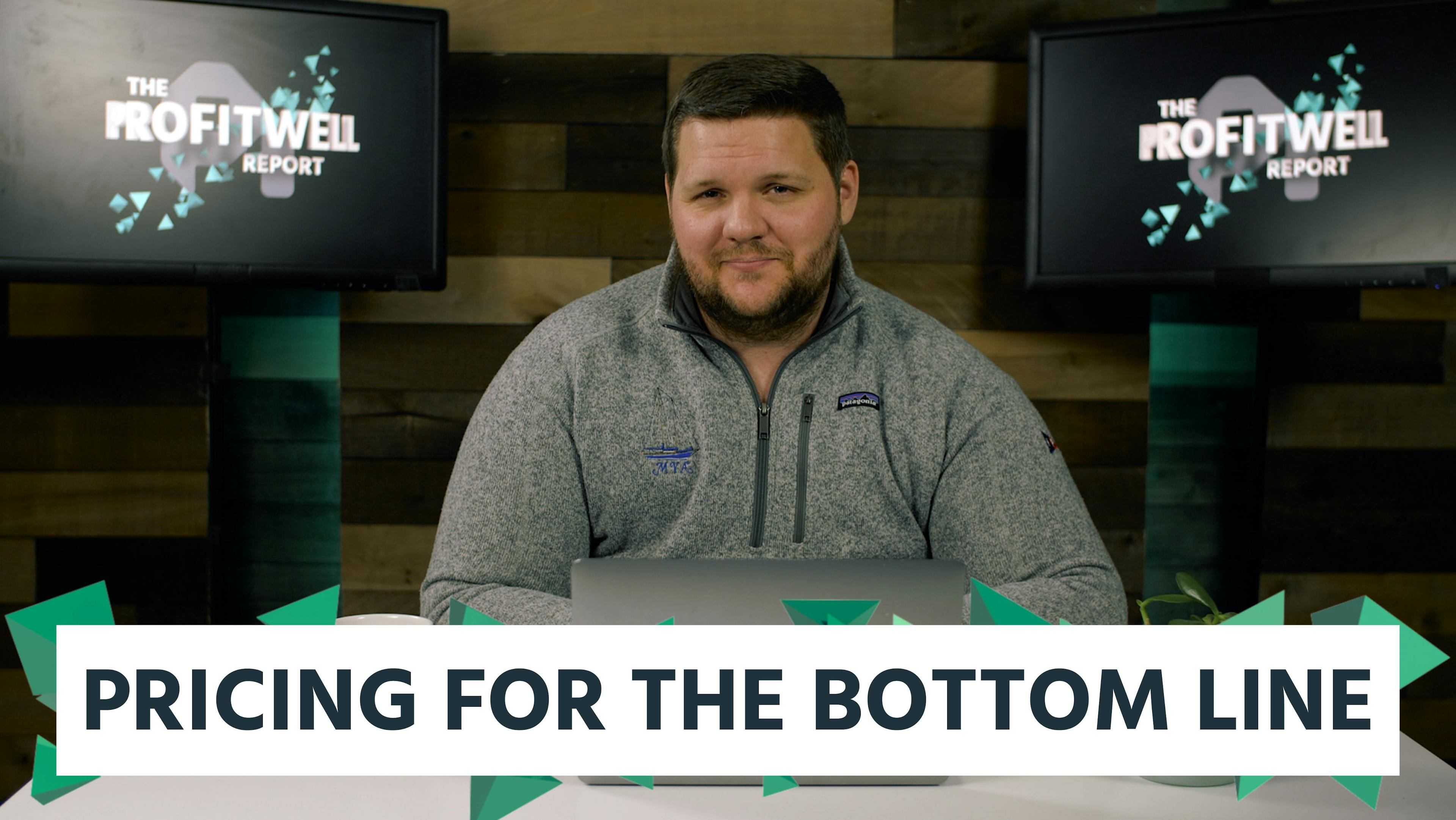
How Integrations Impact Retention
This episode might reference ProfitWell and ProfitWell Recur, which following the acquisition by Paddle is now Paddle Studios. Some information may be out of date.
Originally published: March 10th, 2018
Main Takeaways:
- Products with at least one integration have 10-15% higher retention.
- Willingness to pay (WTP) has decreased 70% over the past 5 years.
- Core products with at least one integration have 10-30% higher WTP.
Integrating various applications into a single platform is crucial for enhancing user retention and maximizing product value. A special thanks to Wade Foster of Zapier for asking the question. Responding to Wade's inquiry, this article delves into how integrations impact customer retention and willingness to pay, underpinned by comprehensive industry data.
But first, if you like this kind of content and want to learn more, subscribe to get in the know when we release new episodes.
Customer Retention With Integrations
Integrations in SaaS products have proven to be more than just a luxury; they are a necessity that significantly impacts customer retention. Data gathered from over half a million software users shows that customers with even one integration exhibit a 10% better retention rate than those without. This improvement in retention continues to rise, reaching an increase of 3 to 7% as the number of integrations climbs to four or more.

The Market is Dropping Out Beneath Us
Despite the clear benefits of integrations on retention, the market's willingness to pay for these integrations has seen a stark decline. Over the past few years, the cost associated with implementing integrations has decreased substantially, largely due to the ease of access provided by automation tools like Zapier. This has led to a nearly 70% reduction in the willingness to pay for integrations, signaling a significant shift in how these features are valued within the software industry.

Willingness to Pay With Integrations
While the direct costs for integrations may be falling, the value they add to a product is increasing. Data shows that users who incorporate one to three integrations are willing to pay 8 to 13% more for the core software product. This willingness to pay escalates dramatically to over 20% as the number of integrations increases to five or more. The correlation between integrations and increased willingness to pay holds true across all business sizes, from SMBs to large enterprises, underscoring the indirect value that integrations bring to SaaS products.

What's Next?
This analysis confirms the crucial role of integrations in the SaaS industry, not just for enhancing product functionality but also for significantly improving customer retention and perceived value. As the software market continues to mature, the strategic importance of integrations is likely to grow even further.
Want to learn more? Check out our recent episode: Mastering Freemium: Crucial Benchmarks and subscribe to the show to get new episodes.
1
00:00:00,240 --> 00:00:03,660
You've got the questions
and we have the data.
2
00:00:03,680 --> 00:00:07,360
Each week, we dive deep on benchmarks
of the subscription economy that
3
00:00:07,360 --> 00:00:09,475
you just can't get anywhere
4
00:00:10,475 --> 00:00:10,875
else.
5
00:00:10,875 --> 00:00:13,975
This is the ProfitWell Report.
6
00:00:16,395 --> 00:00:17,890
Hey, Patrick. Quick question.
7
00:00:17,890 --> 00:00:21,730
Do you know how
integrations affect people's retention of
8
00:00:21,730 --> 00:00:23,490
the SaaS products they use?
9
00:00:23,490 --> 00:00:24,850
Let me know.
10
00:00:24,850 --> 00:00:27,035
Awesome. Awesome question, Wade.
11
00:00:27,035 --> 00:00:28,795
Integrations used
to be a luxury.
12
00:00:28,795 --> 00:00:31,515
The simple software we used
was kind of like the bread and
13
00:00:31,515 --> 00:00:32,635
water of functionality.
14
00:00:32,635 --> 00:00:35,035
So bringing multiple
applications together just kind
15
00:00:35,035 --> 00:00:37,800
of felt like an indulgence
that we just couldn't afford.
16
00:00:37,800 --> 00:00:37,960
Yeah.
17
00:00:37,960 --> 00:00:39,320
With the explosion of software,
18
00:00:39,320 --> 00:00:41,960
bringing together all of the
different tools we use to act
19
00:00:41,960 --> 00:00:44,680
as a coordinated unit
isn't just table stakes,
20
00:00:44,680 --> 00:00:48,005
it's a necessity or
so the data shows us.
21
00:00:48,005 --> 00:00:48,965
To answer Wade's question,
22
00:00:48,965 --> 00:00:51,525
we looked at the willingness
to pay data from over half a
23
00:00:51,525 --> 00:00:54,700
million software consumers,
and here's what we found.
24
00:00:54,700 --> 00:00:55,980
As to not vary the lead,
25
00:00:55,980 --> 00:00:58,700
the number of integrations
your customers use within your
26
00:00:58,700 --> 00:01:01,725
product has a noticeable
impact on retention.
27
00:01:01,725 --> 00:01:04,925
Customers with even one
integration have ten percent or
28
00:01:04,925 --> 00:01:09,110
better retention on an absolute basis
than those who have no integrations.
29
00:01:09,110 --> 00:01:12,070
Further, as integrations
increase to four or more,
30
00:01:12,070 --> 00:01:14,950
retention appears to increase
by an additional three to seven
31
00:01:14,950 --> 00:01:16,575
percent on an
32
00:01:17,255 --> 00:01:19,975
Retention doesn't really tell
the whole story though because
33
00:01:19,975 --> 00:01:22,615
this improvement in retention
isn't coming from people
34
00:01:22,615 --> 00:01:24,755
upgrading to purchase
integrations.
35
00:01:25,000 --> 00:01:27,640
Instead, willingness to pay
for integrations has actually
36
00:01:27,640 --> 00:01:31,080
declined by nearly seventy
percent over the past few years
37
00:01:31,080 --> 00:01:34,040
on the back of integrations
becoming easier and easier to
38
00:01:34,040 --> 00:01:37,385
implement, Thanks in no
small part to Zapier.
39
00:01:37,385 --> 00:01:40,665
Instead, these customers appear to
be getting an increased amount of
40
00:01:40,665 --> 00:01:43,430
value from the products from
which they're integrating.
41
00:01:43,430 --> 00:01:45,030
When measuring
willingness to pay,
42
00:01:45,030 --> 00:01:47,670
those customers who have one to
three integrations are willing
43
00:01:47,670 --> 00:01:51,670
to pay eight to thirteen percent
more for the same core product.
44
00:01:51,670 --> 00:01:54,695
Those with five or more start
breaking into twenty percent
45
00:01:54,695 --> 00:01:56,615
plus higher willingness to pay.
46
00:01:56,615 --> 00:02:00,055
Perhaps most telling though
is this correlation is consistent
47
00:02:00,055 --> 00:02:05,030
amongst business buyers of all types
from SMBs all the way up to enterprises.
48
00:02:05,030 --> 00:02:08,870
Essentially, integrations indirectly
boost the retention and product
49
00:02:08,870 --> 00:02:11,085
willingness to pay
of your core product.
50
00:02:11,085 --> 00:02:14,765
After all, if someone starts to
rely on you as basically a platform
51
00:02:14,765 --> 00:02:17,950
through which value flows
through one cohesive unit,
52
00:02:17,950 --> 00:02:20,270
then there's no way they'll
remove your product.
53
00:02:20,270 --> 00:02:21,470
Well, that's all for now.
54
00:02:21,470 --> 00:02:24,590
If you want us to dig further into
this data or any other data out there,
55
00:02:24,590 --> 00:02:27,635
shoot me an email or video to
p c at profit well dot com.
56
00:02:27,635 --> 00:02:30,035
And let's also thank Wade
for sparking this research by
57
00:02:30,035 --> 00:02:32,515
clicking below to share on
LinkedIn and give him a nice
58
00:02:32,515 --> 00:02:33,395
little shout out.
59
00:02:33,395 --> 00:02:35,070
We'll see you next week.
60
00:02:37,190 --> 00:02:39,592
This episode of the ProfitWell
Report is brought to you by
61
00:02:39,592 --> 00:02:40,312
HelpScout.
62
00:02:40,312 --> 00:02:42,952
HelpScout makes excellent
customer service achievable for
63
00:02:42,952 --> 00:02:44,312
companies of all sizes.
64
00:02:44,312 --> 00:02:46,147
HelpScout dot net.





